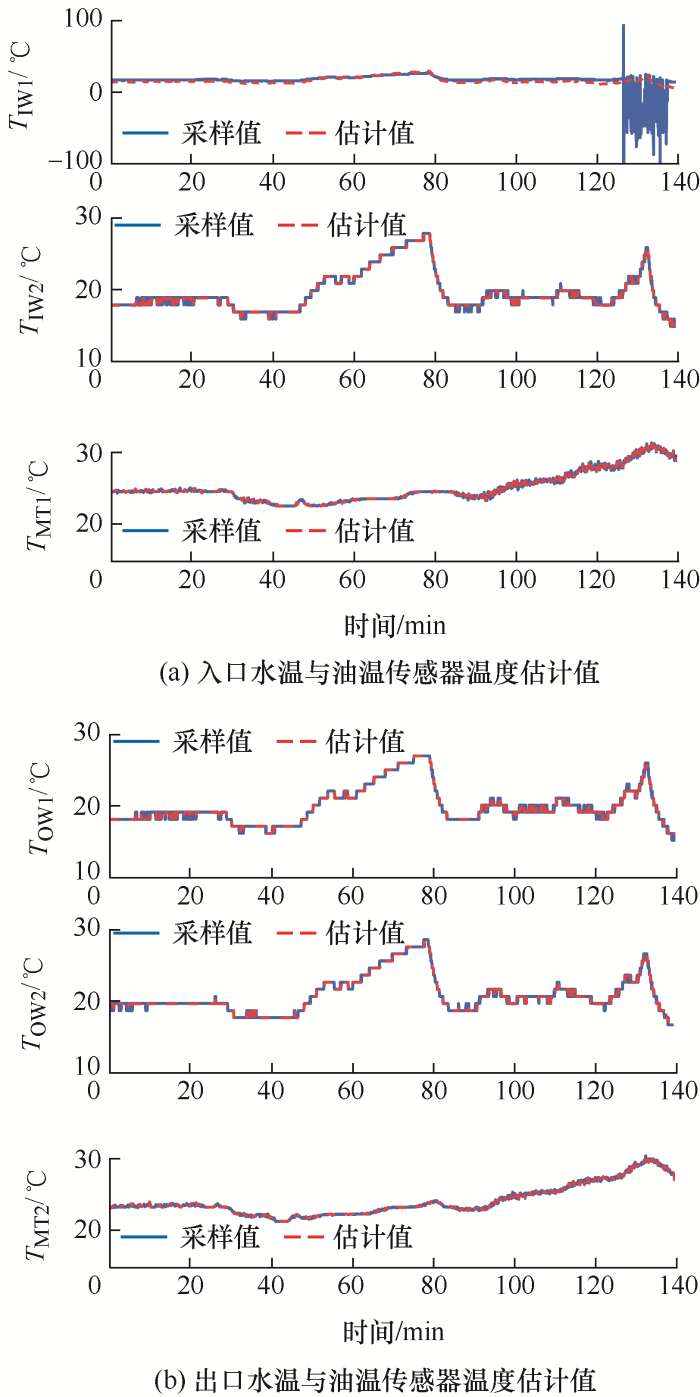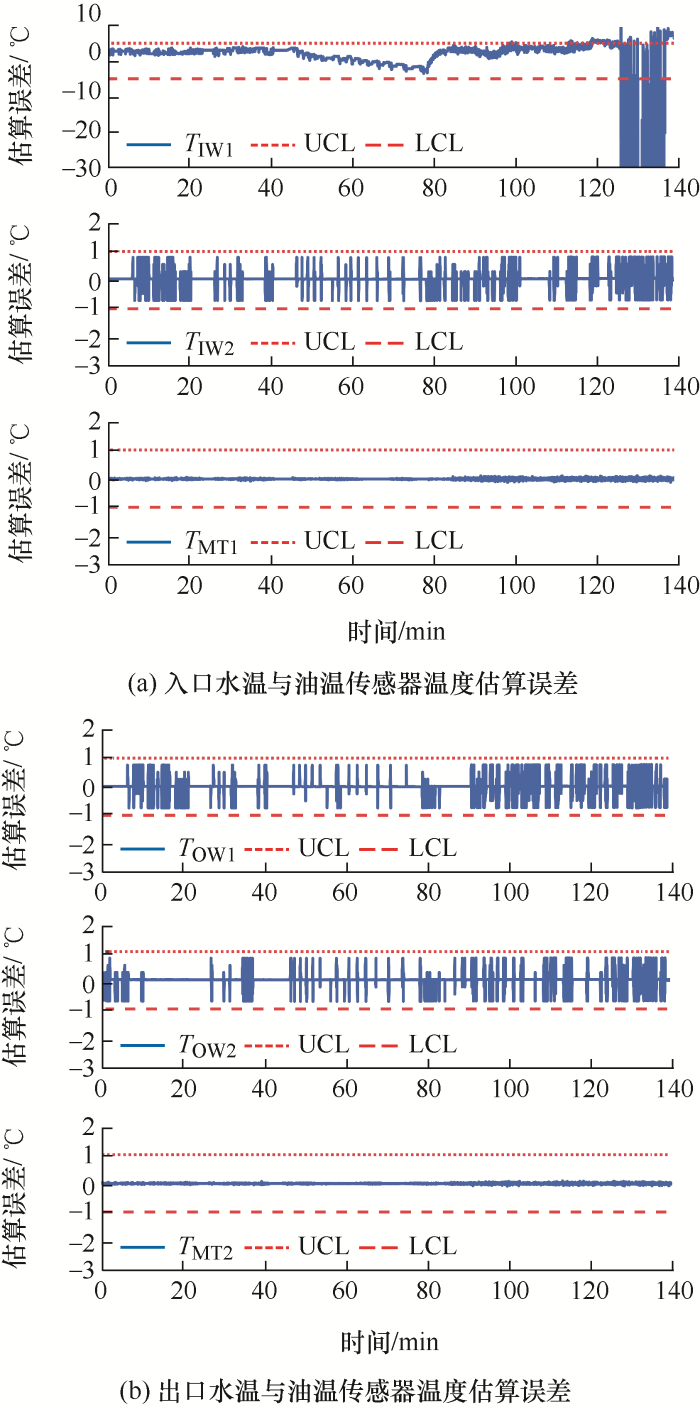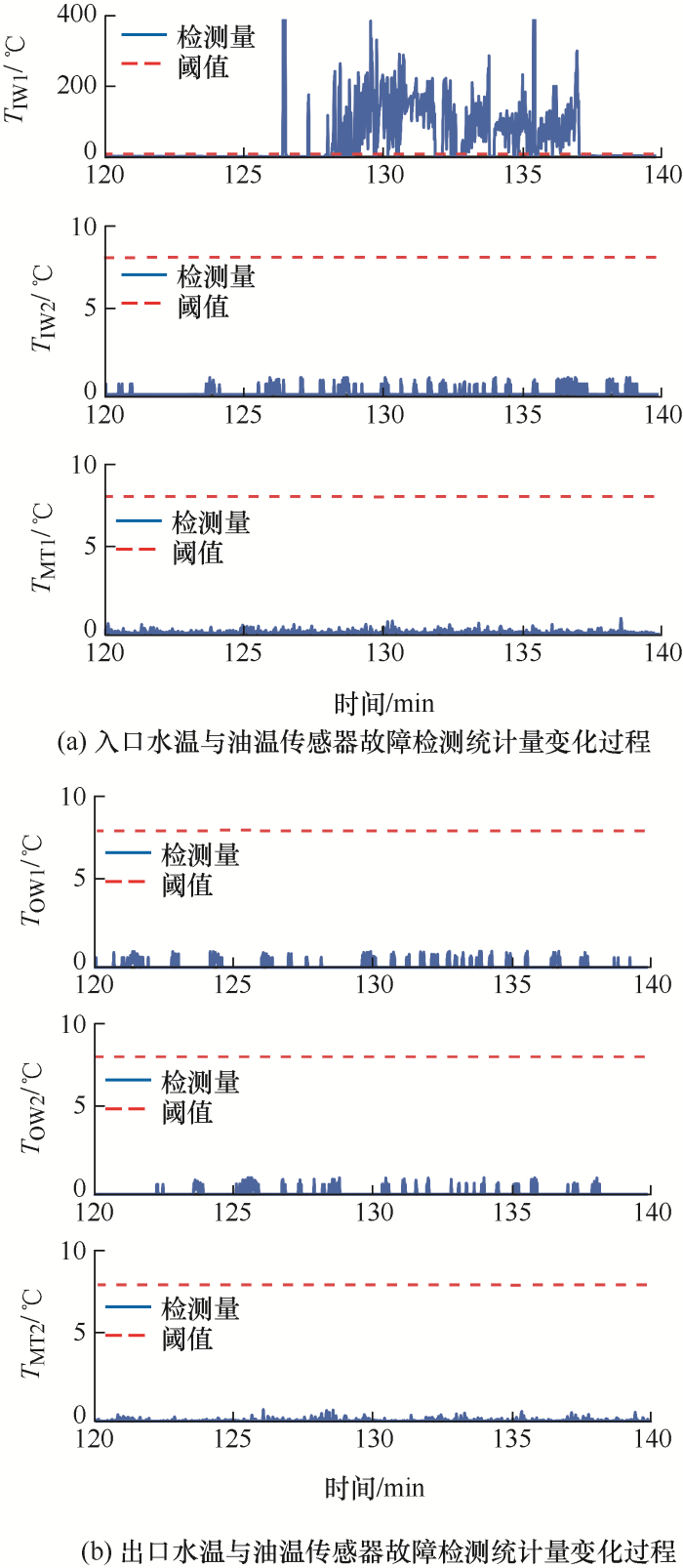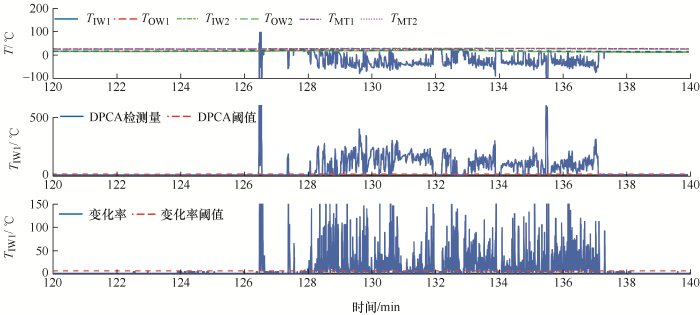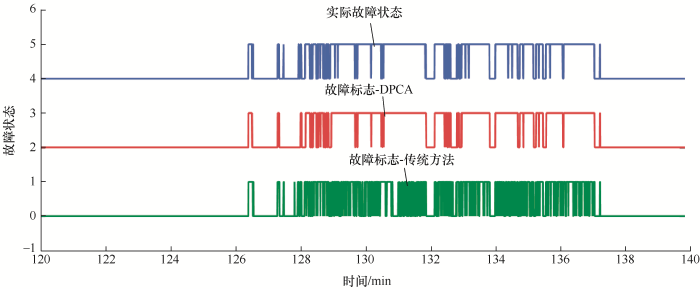1 引言
近年来,列车牵引传动系统传感器故障诊断引起了国内外学者关注[6]。传感器故障诊断方法大致可分为解析模型法、信号分析法与基于数据驱动的方法[7]。解析模型法能够清晰描述系统结构与故障特征之间的关系,通过对传感器测量信号建立状态观测,然后根据观测输出与测量输出的残差变化规律,设置阈值来诊断传感器故障。文献[8-9]分别采用滑模观测器与龙伯格观测器进行测量值估计,基于估计值与实测值之间的残差,对列车脉冲整流器中的直流侧电压传感器与网侧电流传感器进行故障诊断。文献[10]采用自适应观测器与决策论相结合的方法,对牵引电机与逆变器系统的速度、电流与直流电压的3种传感器进行故障诊断。信号处理的方法直接从测量信号出发,无需建立数学模型,通过在时域、频域、时频分析的方式提取特征,来分析特定的故障信息。文献[11]基于三相电机电流,通过提取并比较正常工况与故障工况下不同相电流传感器的相关特征实现故障诊断。数据驱动的方法不依赖于数学模型,工程实用性强[12],在高速列车牵引传动系统故障诊断中,越来越受到国内外学者的关注[13]。文献[14]提出了一种基于智能时间自适应集成极值学习机(Extreme learning machine, ELM)的三相逆变器传感器故障诊断方法,并基于半实物仿真验证了算法的有效性。文献[15]基于主成分分析法(Principal component analysis, PCA)对变频器供电的感应电机定子进行了故障诊断。为了改善PCA方法诊断性能,文献[16]提出了将深度PCA模型用于多传感器潜在故障诊断。针对高速列车非线性非高斯的时间序列数据特点,文献[17]进一步将PCA与概率事件相结合,用于传感器潜在故障诊断。为了提高模型的鲁棒性,文献[18]将赫林格距离引入了PCA框架。为此本文将结合列车温度传感器的数据关联及变化规律,将PCA的改进方法应用在温度传感器测量值的实时估计。
为此本文在不改变现有硬件基础上,基于牵引系统各温度传感器间的关联关系,以温度传感器的历史正常样本数据为基础,提出了基于信息融合的多温度传感器智能故障诊断方法。首先基于动态主成分分析法对系统内温度传感器温度值进行估计,然后基于估计值与测试值的残差变化规律,对温度传感器的异常状态进行辨识与隔离,最后用现场故障案例对所提方法的有效性进行了验证。
2 系统温度监测与故障诊断机制
2.1 牵引传动系统中温度信号采集机制
为了确保列车主要部件的正常运行以及出现异常时及时有效保护,在列车牵引系统的牵引变压器、牵引变流器、牵引电机等主要部件内均装有温度传感器。通常牵引电机为强迫风冷方式,采用独立的牵引风机和通风管道进行冷却。而牵引变流器与牵引变压器则分别为水冷和油冷散热,采用油、水复合冷却系统对其进行冷却。
以某型动车组牵引系统为例,其复合冷却系统原理示意图如图1所示,牵引变流器的温度传感器分别安装于冷却水管进出口位置,用来测量内部进、出口水温的温度,牵引变压器温度传感器安装于牵引变压器内部顶端,用来测量内部油温温度。每套牵引系统通常包括4个水温传感器和2个油温传感器。控制系统实时采集这些温度值,并对温度异常进行诊断与保护。为此本文将对牵引传动系统的这6个温度传感器的故障展开研究,通过挖掘它们之间的相关性,实现每个温度值的高精度估计与故障诊断功能。
图1
2.2 现有温度传感器故障诊断方法
目前牵引系统中通常根据温度传感器采样值读数是否异常或变化过快[13],即简单超限报警方法来进行温度传感器故障诊断。此方法依据工程应用经验,设定温度传感器采样值及其变化率的正常工作范围,若超过此范围,则认为此温度传感器存在故障,其数学表达描述如式(1)所示
式中,F为传感器故障标志,为1代表发生故障,为0代表工作正常;T和ΔT分别表示温度传感器采样值及其变化率;Th1和Th2为温度传感器正常采样阈值上下限;Th3和Th4为温度传感器正常采样值变化率阈值上下限。
3 基于动态主成分分析法的故障诊断方法
3.1 动态主成分分析法基本原理
PCA[14]是一种多变量统计方法,用于对含有噪声的和高度相关的测量数据进行分析。它采用线性降维技术,把高维信息投影到低维子空间,并保留主要过程信息,从而可用少数的主元描述高维的数据矩阵。假设X为n×m的数据矩阵,n对应数据样本数,m对应变量个数。则对矩阵X中的每个变量进行标准化处理后,可分解为如下形式
式中,
式中,
X的分解使合成矩阵[PPe]和[TTe]均为正交矩阵,主成分分解使原始变量集减少成l个主成分。由于[PPe]是正交的,因此
式(5)表示
X在估计子空间的映射称为主成分空间(Principal component subspace, PCS),可通过式(6)计算。
式中,将矩阵PPT用C表示,C通常为秩亏矩阵,即l<m。
上述通用PCA方法是假定某时刻测量值对于前面时刻测量值来说是统计独立的[17],这对于长采样间隔是有效的,但对于动态系统,因采样间隔短,存在储能环节,其数据采样之间具有时序相关性,即当前采样值与历史采样值强相关。因此需要对数据矩阵进行扩张,增加历史时刻数据,以表示变量的动态关系。
令扩张后的数据矩阵为
式中,
通过对式(7)的数据矩阵进行PCA处理,可以从数据中得到包含系统输入的多变量自回归(Autoregression, AR)模型,基于式(7)的PCA方法称为动态主成分分析法(Dynamic principal component analysis, DPCA)。
3.2 基于DPCA的温度估计
设传感器测量值与估计值分别为
式中,x代表矩阵X的行向量,即一个传感器采样向量;C可基于历史故障数据样本得出。
设六个温度传感器采样值分别表示为入口水温传感器TIW1,出口水温传感器TOW1,入口水温传感器TIW2,出口水温传感器TOW2,入口油温传感器TMT1和出口油温传感器TMT2,则可扩张后的数据矩阵X(h)如式(9)所示
式中,
利用式(8)进行传感器测量值估计时,若x中包含故障传感器采样值,则故障传感器相关采样值仍然在估计中。为了消除故障传感器的影响,采用式(10)[16]来重构第
式中,
以入口水温传感器故障检测的传感器测量值估算为例,基于式(8)进行某传感器估算时,其传感器采样值向量Z(1)为
式中,
同理,利用式(10)可得到基于其他5个传感器重构替代的采样值向量,依次记为Z(2)~Z(6),基于此重构替代采样值,利用DPCA算法,基于式(12)进行估算。
3.3 温度传感器故障检测
基于上述分析,设传感器采样值矢量为x,则进行第i个传感器故障检测时,可基于式(13)来进行残差
式中,
完成残差设计后,下一步是构造合适的检测量用于故障检测。在正常运行时,若系统无故障,则残差
选择数据周期采样窗口长度为m,即每次截取m个
式中,k为当前采样时刻。
选择相应的显著水平为
式中,
3.4 基于温度传感器的故障隔离
表1 故障诊断规则表
| 序号 | 条件 | 结论 |
|---|---|---|
| 1 | F1(1)=1, F2(1)=0, F3(1)=0, F4(1)=0, F5(1)=0, F6(1)=0 | FIW1=1 |
| 2 | F1(2)= 0, F2(2)=1, F3(2)= 0, F4(2)= 0, F5(2)=0, F6(2)= 0 | FOW1=1 |
| 3 | F1(3) = 0, F2(3) = 0, F3(3)=1, F4(3)=0, F5(3)=0, F6(3)=0 | FIW2=1 |
| 4 | F1(4)= 0, F2(4) =0, F3(4) =0, F4(4)=1, F5(4) =0, F6(4)=0 | FOW2=1 |
| 5 | F1(5)=0, F2(5)= 0, F3(5)= 0, F4(5)= 0, F5(5)= 1, F6(5)=0 | FMT1=1 |
| 6 | F1(6)=0, F2(6)=0, F3(6)=0, F4(6)=0, F5(6)=0, F6(6)=1 | FMT2=1 |
4 现场故障数据测试验证
为验证所提算法的有效性,本文以某实际列车的牵引传动系统温度采集数据为研究对象,包括4个入水口水温传感器与2个油温传感器的数据,数据样本共470个,每个样本包含17 500个采样点,采样周期为0.3 s,数据周期采样窗口长度为3,采用文献[22]中的评价指标故障检测率(False discovery rate, FDR)进行评价,与传统方法对比研究。FDR计算方法如式(16)所示
式中,Nf为总的故障样本数;J表示故障检测统计量;Jth为相关阈值。
图2
图3
图4
图5
图6
5 结论
牵引传动系统关键部位温度是列车相关设备运行状态的重要指标,温度传感器故障诊断对列车安全稳定运行具有重要意义,针对目前工程上传统的诊断方法仍存在的漏报问题,本文提出了基于信息融合多传感器故障实时诊断方法,此方法创新性主要体现在如下三个方面。
(1) 针对各温度传感器检测值校准问题,充分利用牵引传动系统中各温度传感器之间的冗余关系,提出了基于DPCA方法的温度传感器温度容错估计方法。
(2) 基于估算温度的测量模型,通过构造相关统计量实现了温度传感器异常辨识与隔离方法。
(3) 通过与传统方法比较研究,用现场故障样本进行对比测试,结果表明,所提方法能有效降低漏报并具有容错估计功能,可提升列车可用性和智能化水平。
参考文献
Real-time fault diagnosis of pulse rectifier in traction system based on structural model
[J].DOI:10.1109/TITS.2015.2393752 URL [本文引用: 1]
自动驾驶电力机车牵引变流器中IGBT寿命损耗优化策略
[J].
Optimization strategy of IGBT life loss in traction converter of autonomous driving electric locomotive
[J].
HXD3B机车牵引变压器虚假过热故障的分析
[J].
Analysis of false overheating fault of traction transformer of HXD3B locomotive
[J].
温度传感器智能故障诊断和容错估计
[J].
Intelligent fault diagnosis and fault tolerant estimation of temperature sensors
[J].
A review of fault detection and diagnosis for the traction system in high-speed trains
[J].DOI:10.1109/TITS.6979 URL [本文引用: 1]
Data-driven fault diagnosis for traction systems in high-speed trains:A survey,challenges and perspectives
[J].DOI:10.1109/TITS.2020.3029946 URL [本文引用: 1]
车载牵引变流系统故障诊断与容错控制综述
[J].
DOI:10.13234/j.issn.2095-2805.2020.1.28
[本文引用: 1]

车载牵引变流系统作为高速列车的动力源,其安全可靠性对保障高速列车安全、高效、可靠的运行和维护至关重要。在非线性、强耦合和多工况等复杂条件和恶劣环境中长期运行,牵引变流系统中的各类部件都会出现不同程度的劣化失效,引发各类故障,给高速列车的安全运行带来极大挑战。为此,针对高速列车车载牵引变流系统功率器件、牵引控制单元、传感器和中间直流环节等故障率高的部件进行了故障诊断与容错控制方法的调研和总结,对比分析不同方法的研究思路和适用条件。最后,讨论车载牵引变流系统故障诊断与容错控制研究中亟待解决的问题,并对未来的研究做出展望。
Overview of fault diagnosis and fault-tolerant control methods for vehicular traction converter system
[J].
DOI:10.13234/j.issn.2095-2805.2020.1.28
[本文引用: 1]

As the driving source of high-speed trains, the vehicular traction converter system is critical to ensuring their safe, efficient and reliable operation and maintenance. In the long-term operation under complex conditions and harsh environments such as nonlinearity, strong coupling, and multiple operating conditions, various components in the traction converter system may encounter different degrees of deterioration failure, causing various types of failures and further affecting the safe operation of high-speed trains seriously. With regard to this, the fault diagnosis and fault-tolerant control methods for the components with a high failure rate in the vehicular traction converter system of high-speed trains, including power devices, traction control unit, sensors, and intermediate DC-link, are investigated and summarized in this paper. Moreover, the research ideas and applicable conditions for different methods are compared and analyzed. Finally, some open problems and challenges in the research of fault diagnosis and fault-tolerant control of the vehicular traction converter system are discussed, and the promising research directions are pointed out.
State observer based sensor fault detection and isolation,and fault tolerant control of a single-phase PWM rectifier for electric railway traction
[J].DOI:10.1109/TPEL.2013.2257862 URL [本文引用: 1]
Sensor fault diagnosis and system reconfiguration approach for an electric traction PWM rectifier based on sliding mode observer
[J].
Detection and isolation of speed-,DC-link voltage-,and current sensor faults based on an adaptive observer in induction-motor drives
[J].DOI:10.1109/TIE.2010.2055775 URL [本文引用: 1]
Speed and current sensor fault detection and isolation technique for induction motor drive using axes transformation
[J].DOI:10.1109/TIE.2014.2345337 URL [本文引用: 1]
Incipient voltage sensor fault isolation for rectifier in railway electrical traction systems
[J].DOI:10.1109/TIE.2017.2696463 URL [本文引用: 1]
An online data-driven method for simultaneous diagnosis of IGBT and current sensor fault of three-phase PWM inverter in induction motor drives
[J].DOI:10.1109/TPEL.2020.2994351 URL [本文引用: 2]
An intelligent time-adaptive data-driven method for sensor fault diagnosis in induction motor drive system
[J].DOI:10.1109/TIE.41 URL [本文引用: 2]
PCA-based on-line diagnosis of induction motor stator fault feed by PWM inverter
[C]//
Deep PCA based real-time incipient fault detection and diagnosis methodology for electrical drive in high-speed trains
[J].DOI:10.1109/TVT.25 URL [本文引用: 2]
Data-driven detection and diagnosis of incipient faults in electrical drives of high-speed trains
[J].DOI:10.1109/TIE.2018.2863191 URL [本文引用: 3]
A newly robust fault detection and diagnosis method for high-speed trains
[J].DOI:10.1109/TITS.6979 URL [本文引用: 1]
HXD3B型机车主变压器温度传感器故障分析及改进
[J].
Failure analysis and improvement of temperature sensor of main transformer on HXD3B locomotive
[J].
CRH3型动车组牵引电机温度传感器故障分析及改进
[J].
Fault analysis and improvement of traction motor temperature sensors for CRH3 EMUs
[J].
CRH380B型动车组走行部温度异常故障分析与研究
[J].
Analysis & research on abnormal temperature failure of CRH380B EMU running gear
[J].



